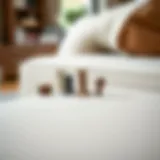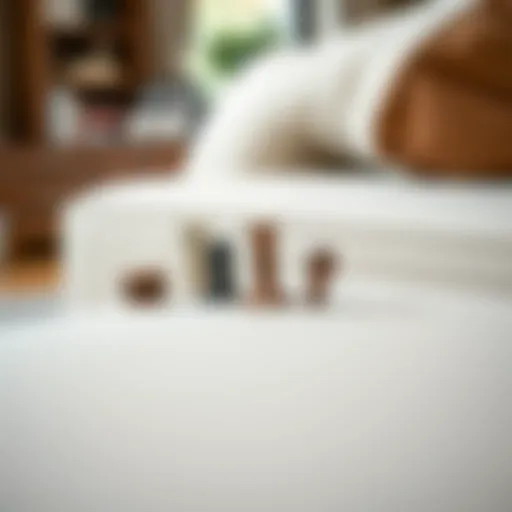Retention Rods in Furniture: Design and Functionality
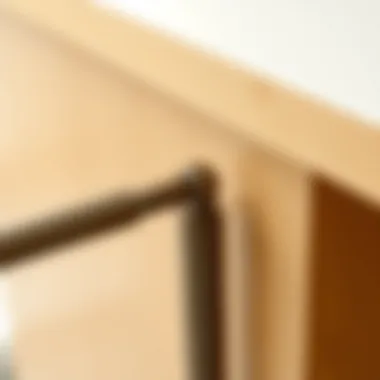

Intro
In the realm of furniture design, often overshadowed by dazzling aesthetics or bold styles, lies a crucial element that warrants attention: the retention rod. These inconspicuous components serve purposes far beyond mere support; they whisper strength and elegance in every piece of furniture crafted with care. As we delve into this intricate subject, it becomes vital to understand how retention rods seamlessly integrate functionality with visual appeal.
Retention rods are the silent guardians ensuring the durability of furniture, making them essential for craftsmanship and design. Their significance, whether in a minimalist chair or an ornate cabinet, cannot be overstated. These rods help maintain structure, preventing sagging or disarray over time, ensuring the longevity of well-loved items. Moreover, they can act as design accents, blending harmoniously with various styles, enhancing both aesthetics and utility.
This article aims to dissect the multifaceted roles retention rods play in furniture creation, from exploring current trends in materials to offering practical insights for discerning enthusiasts and professionals alike. Let’s embark on this journey to appreciate the essential insights that retention rods bring to the craft of furniture design.
Design Trends
Current Trends in Furniture Styles
The landscape of furniture design is constantly shifting, shaped by evolving tastes, materials, and technologies. In recent years, there has been a surge in sustainable practices, where eco-friendly materials like bamboo and reclaimed wood have taken center stage. These natural forms not only look stunning but also offer a nod to environmental consciousness.
Conversely, there has been a revival of retro styles infused with modern flair. Think of bright colors, bold patterns, and unique shapes that take one back in time. Retention rods in such furniture can be subtly incorporated to maintain integrity without compromising on nostalgic charm.
Moreover, modular designs are flourishing. They allow for versatility and personalization. Retention rods in modular pieces provide structural stability, ensuring these adaptable designs stand the test of time.
How to Incorporate Trends into Your Space
Integrating these trends into your home need not be daunting. Here are some insights for the movers and shakers in the realm of design and retail:
- Identify Your Style: Are you drawn to mid-century modern or sleek Scandinavian designs? Knowing your preference helps in selecting pieces that resonate with you.
- Focus on Functionality: Consider how you will use the item. Retention rods not only serve to support structure but can also be a decorative element, showing craftsmanship.
- Explore Versatile Options: Look for furniture that reflects current trends but maintains adaptability. Items with removable or adjustable components can be particularly useful.
In the end, the right furniture can transform a space, and understanding the role of retention rods can help in making thoughtful decisions that resonate with both style and substance.
Understanding Retention Rods
In the realm of furniture design, retention rods serve a pivotal role that often flies under the radar. They are not merely structural components but essential elements that enhance both the integrity and beauty of furniture pieces. Understanding retention rods means grasping their significance in combining functionality with design. By comprehending what they offer, designers and homeowners alike can make informed decisions when selecting or creating furniture.
Definition and Purpose
Retention rods, also known as tension rods or structural rods, are typically cylindrical supports made from various materials such as wood, metal, or composites. Their primary purpose is to help stabilize structures and distribute weight effectively. The characteristics that set these rods apart include their ability to manage tensile forces, thus preventing deformation and ensuring longevity in furniture pieces.
A simple way to think about it is like the backbone of a chair or a bed frame; without it, the weight might cause the whole structure to collapse or warp. This aspect becomes especially crucial when discussing larger items that sustain significant stress.
In furniture design, these rods not only fortify the physical structure, but they also create a visual streamlining effect, often seamlessly integrated into the overall aesthetic. Their functional yet stylish presence is a prime consideration for many designers today.
Historical Development
The concept of retention rods can trace its lineage back through centuries of furniture making. Initially, craftsmen relied on solid wood joints and mortise-and-tenon techniques to create sturdy pieces. As furniture evolved, so did the materials and methods used in production. In the 19th and early 20th centuries, the introduction of metals, particularly steel, began to gain traction among furniture makers. This change was largely driven by the Industrial Revolution, which emphasized speed and efficiency in production.
With time, designers started developing specialized retention rods that were not only functional but could also contribute to a piece's artistic voice. Italian and Scandinavian designers, for example, have often utilized retention rods in innovative ways, not just for strength but also for visual appeal. Their designs inspired an era of sleek lines and minimalist aesthetics, integrating retention rods as visible elements of a design rather than concealing them.
Today, we see retention rods in various forms across residential and commercial settings, reflecting both the time-honored traditions of craftsmanship and contemporary design philosophies. Understanding this evolution helps us appreciate the meticulous thought behind why these rods are still crucial in modern furniture design.
Types of Retention Rods
In the realm of furniture design, retention rods serve as the backbone for stability and style. Understanding the types of retention rods is essential for selecting the right fit for any piece of furniture. Each type not only impacts the structural integrity but also contributes to the aesthetic appeal. This section will dive into the materials used and the various design variations, helping designers and homeowners alike make informed choices.
Materials Used
Wooden Retention Rods
Wooden retention rods carry a unique charm that seamlessly integrates with various furniture styles. Their natural grain and warmth add an organic touch, making them a popular choice for traditional and rustic designs. A notable feature of wooden rods is their ability to absorb moisture, which can prevent warping when treated properly. However, their susceptibility to scratches and dents can be a disadvantage, especially in high-traffic areas.
Benefits of Wooden Retention Rods:
- Aesthetic appeal: Fits well with a range of designs.
- Eco-friendly: Sources from sustainable forests can boost green credentials.
Considerations:
- Maintenance: Regular lacquer or polish can prolong lifespan.
- Structural limits: Heavy loads should be approached with caution, as wood can snap under excessive strain.
Metal Retention Rods
Metal retention rods, often made from steel or aluminum, are synonymous with strength and durability. They stand up to mechanical stress and environmental changes, making them a reliable option for commercial and outdoor furniture. One distinctive feature is their design versatility; they can be finished in various ways, from sleek chrome to matte black.
Benefits of Metal Retention Rods:
- Strength: Capable of handling significant weight without bending.
- Low maintenance: Resistant to pests and moisture, requiring minimal upkeep.
Considerations:
- Aesthetic clash: May not suit all furniture styles, particularly softer designs.
- Heat transfer: Metal can become hot under direct sunlight, which might be a factor in some settings.
Composite Retention Rods
Composite retention rods blend materials, often combining plastic and metal, leading to a lightweight yet strong construction. Their flexibility and resilience make them an excellent choice for innovative designs. A unique aspect of composite rods is their design adaptability—they can be created in various colors and textures to fit modern furniture styles perfectly.
Benefits of Composite Retention Rods:
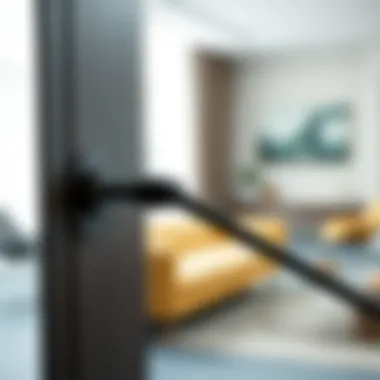

- Lightweight: Easy to install and move around.
- Customizable: Can be manufactured in various shapes and sizes for unique furniture needs.
Considerations:
- Long-term strength: While they offer immediate benefits, their longevity under stress compared to metal rods may vary.
- Cost implications: Generally, these may be more expensive due to the advanced manufacturing processes involved.
Design Variations
Standard Retention Rods
Standard retention rods are the baseline models that provide essential support without any frills. Their straightforward design ensures that they are adaptable to various furniture pieces, ranging from sofas to shelving units. They're often made from either wood or metal, catering to different styles.
Benefits of Standard Retention Rods:
- Universality: Easy to incorporate into many furniture styles.
- Cost-effective: Generally less expensive than specialized rods.
Considerations:
- Limited customization: Fewer options for unique designs compared to decorative types.
- Basic aesthetic: Might not satisfy a design-conscious homeowner looking for flair.
Adjustable Retention Rods
Adjustable retention rods offer versatility by allowing for variations in length and height. This adaptability makes them ideal, especially for multifunctional furniture where changing requirements are expected. Their contemporary design often appeals to a modern audience.
Benefits of Adjustable Retention Rods:
- Customization: Users can tailor the fit to their specific needs.
- Integration: Great for furniture that might need to shift locations or purposes.
Considerations:
- Complexity: They may require more technical understanding for installation.
- Price: Generally higher due to their adjustable nature and mechanisms involved.
Decorative Retention Rods
Decorative retention rods are where function meets form. These rods do more than just secure furniture; they enhance the overall aesthetic. Often made in elaborate designs or enriched with decorative finials, they are visible components that add flair to furniture.
Benefits of Decorative Retention Rods:
- Aesthetic appeal: They complete the look of more elaborate furniture pieces.
- Variety: Available in numerous styles, materials, and finishes.
Considerations:
- Cost: Generally more expensive than standard models due to their artistic nature.
- Maintenance: Decorative details may require more upkeep to keep them looking pristine.
The type of retention rod selected can significantly influence both the utility and beauty of a furniture piece, making it a decision that should involve careful consideration.
Functional Significance
Understanding the functional significance of retention rods is crucial for anyone involved in furniture design, from seasoned professionals to enthusiastic DIYers. These rods are more than mere components; they form the backbone of construction, directly impacting stability, durability, and aesthetic integration of furniture. Grasping their role can lead to more informed choices during both design and selection processes.
Role in Furniture Stability
Retention rods are often the unsung heroes of furniture stability. Without them, many structures could easily topple or sag over time due to everyday use and environmental factors. These rods help to maintain the integrity of furniture by preventing unnecessary movement.
Consider the joint where a chair's leg meets its seat. The addition of a retention rod strengthens this connection. It acts almost like a bridge, ensuring that the various parts don't move independently. This is especially critical in high-use areas, such as dining rooms or living spaces where furniture endures continuous pressure and weight.
In addition to providing strength, retention rods help distribute weight evenly. For example, in a heavy wooden coffee table, the retention rods ensure that the weight is not concentrated in one weak spot, which could lead to cracks or collapse. This preemptive measure not only prolongs the life of the furniture but also enhances the safety of users.
Impact on Load Distribution
Moving on, the impact on load distribution really highlights how essential these rods can be. When designing furniture, understanding how weight moves across a piece can influence critical decisions. Retention rods play a pivotal role in this process. They ensure that weight is never too heavy on a single point, effectively reducing the risk of structural failure.
- Balance: Retention rods help achieve balance in design. Imagine a bookshelf sagging under the weight of several heavy tomes. By strategically placing retention rods, not only does the shelf gain stability, but it can also support heavier loads that would traditionally cause warping or bending.
- Longevity: When weight is distributed evenly, it minimizes wear and tear. This guarantees that your beloved pieces can weather both daily use and the occasional earthquake of life. The longer the furniture lasts, the less waste ends up in landfills, which is an important consideration in today’s sustainability-focused designs.
When designing consumption-oriented furniture, be it a communal dining table in a bustling restaurant or a trendy display for retail, the load distribution facilitated by retention rods cannot be overstated. They are essential to crafting pieces that stand the test of time and meet consumer demands without compromising safety or function.
"The careful integration of retention rods not only stabilizes structures but initiates an enduring relationship between design and utility."
In summary, the functional significance of retention rods extends beyond mere support. They enhance furniture stability, ensure balanced load distribution, and promote longevity. Furniture can be a significant investment, and understanding the role of retention rods ensures that every piece works hard to meet the demands of modern life.
Application in Furniture Design
The role of retention rods in furniture design cannot be overstated. They act as vital components that ensure both durability and aesthetic appeal in a wide array of furniture types. Understanding how these rods are incorporated into various designs helps in maximizing their benefits. Whether in residential or commercial spaces, retention rods serve distinct purposes that cater to functionality and visual style, aligning with the broader objectives of furniture design.
Residential Furniture
Living Room Pieces
In the realm of living room furniture, retention rods offer structural integrity that is essential for pieces like couches and entertainment centers. Their primary characteristic is that they help stabilize frame constructions, ensuring these items withstand regular use. A prevalent choice for homeowners, these rods are often designed to blend seamlessly with upholstery or wood finishes.
One unique feature of living room furniture incorporating retention rods is the ability to enhance load-bearing capacity. The rods allow the furniture to maintain its form, even under weighty objects like adorned cushions or electronic devices. However, a downside can be the installation complexity; improper fitting can lead to instability, affecting both safety and comfort.
Bedroom Essentials
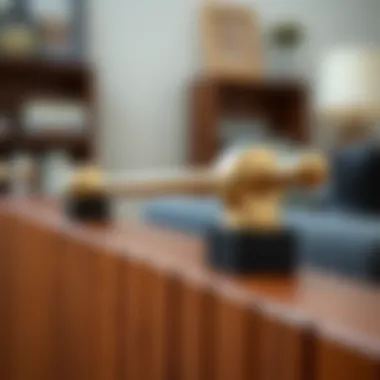

For bedroom essentials, such as beds and dressers, retention rods play an equally crucial role. They ensure that beds remain sturdy, maintaining alignment and support, which is important for a good night’s sleep. The key characteristic of bedroom furniture with retention rods is the potential for minimizing creaking and movement due to weight fluctuations.
A unique advantage of using retention rods in bedroom furniture is the customization options they provide. Designers can manipulate rod configurations to create beds with varying heights and styles. However, on the flip side, an intricate design may complicate maintenance, making cleaning a bit of a hassle in some cases.
Commercial Furniture
Office Desks
In commercial settings, specifically with office desks, retention rods enhance stability and ensure that desks can handle the weight of computers and office supplies without sagging. Key characteristics include reinforcing the structure under high load and providing a steady work surface. This makes them highly preferable in professional environments where productivity relies on reliable furniture.
Among the unique features of office desks that incorporate retention rods is their capability to adapt to different layout requirements. It allows for modular setups with interchangeable components. However, one downside can be balancing aesthetics with functionality; simple designs might come off as uninspiring.
Retail Displays
Finally, retail displays benefit significantly from the inclusion of retention rods. These rods not only support the weight of displayed items but also add an element of design cohesion. The character of these displays often centers on showcasing products elegantly while ensuring stability.
A compelling aspect of retail displays featuring retention rods is their versatility. Retailers can transform displays for seasonal promotions with relative ease as the rods can accommodate diverse shapes and support various materials. On the downside, over-reliance on aesthetic aspects can sometimes compromise the utilitarian nature of the display.
The significance of retention rods in furniture extends beyond mere support; they are the unsung heroes ensuring that form and function coexist harmoniously.
Clearly, retention rods are more than mere incidental parts of furniture design. Their applications in both residential and commercial contexts affirm their necessity and influence in creating durable, attractive, and functional pieces.
Design Considerations
The concept of design considerations in furniture design is multi-faceted, incorporating aesthetic, functional, and ergonomic aspects. In the context of retention rods, which serve crucial roles within various furniture structures, these considerations become even more significant. Selecting the right retention rod involves not just choosing a sturdy piece, but also harmonizing it with the overall design vision of the furniture. Each decision can impact durability, comfort, and visual appeal.
Aesthetic Integration
When it comes to aesthetics, the harmony between the retention rod and the rest of the furniture is paramount. The choice of materials and finishes can either elevate or detract from a piece of furniture. For instance, a sleek metal retention rod may pair well with modernistic furniture, infusing a sense of minimalism and sophistication. Conversely, for traditional styles, wooden retention rods can create a warm, inviting feel, complementing the organic textures of the wood.
Consider the following elements while integrating retention rods into your furniture design:
- Color Matching: Ensure the rod's color aligns with the overall palette. A dissonant hue could stand out for all the wrong reasons.
- Texture: The texture should enhance the tactile experience of the furniture. Smooth rods might be more suitable for modern designs, while a rustic finish would enhance vintage pieces.
- Proportion and Scale: The rod must fit proportionally within the furniture. A macroscopic rod on a delicate structure could overshadow its elegance, whereas a petite rod might be lost on a larger piece.
Choosing the right aesthetic elements not only reflects personal style but also enhances the attractiveness of the furniture itself, making it appealing to a broader market.
Ergonomic Factors
Incorporating retention rods also prompts a focus on ergonomics, which pertains to how users interact with furniture in terms of comfort and efficiency. Ergonomically designed retention rods can significantly contribute to the overall user experience in multiple ways.
Key ergonomic considerations include:
- Height and Reach: The placement of retention rods can affect how easy it is to use the furniture. For instance, a coffee table with retained structure allows for safer reachability and comfort for low-sitting users.
- Stability: A well-placed retention rod may offer more stability, thus allowing users to rest easier with the assurance that their furniture won’t wobble or collapse. This aspect can particularly enhance user confidence, especially in commercial settings.
- Adjustability: Adjustable retention rods offer versatility, allowing furniture to cater to various user needs and preferences. This feature aligns perfectly with the growing trend toward customizable furniture.
"The success of a design often lies in how it serves its purpose, and in the case of retention rods, this intertwines with aesthetics and ergonomics."
In summary, understanding design considerations deeply influences how retention rods contribute to furniture design. Integrating aesthetic and ergonomic factors ensures that these rods are not just functional entities but enhance the overall user experience, fulfilling both form and purpose seamlessly.
For further reading on furniture design best practices, you may visit resources such as Wikipedia Furniture and Britannica on Design to enhance your appreciation of these pivotal elements.
Durability and Maintenance
In the realm of furniture design, the durability and maintenance of structural elements cannot be overstated. Retention rods, though often overlooked, play a pivotal role in ensuring furniture longevity and functionality. These rods—whether wooden, metal, or composite—are the backbone that supports not just the weight, but also the aesthetic integrity of furniture pieces. Without proper attention to their durability and maintenance, even the most elegantly designed furniture can falter over time.
Key Benefits of Durability
The primary advantage of durable retention rods is their contribution to furniture stability. A robust rod can withstand significant weight and wear, reducing the likelihood of bowing or bending. This is particularly important in furniture pieces subjected to constant use, such as dining chairs or sofas. Furthermore, a lasting retention rod minimizes the need for replacements, ultimately resulting in cost savings.
Additionally, durable materials tend to be less susceptible to environmental factors. Wood, for instance, might expand or contract with humidity, impacting its performance and longevity. Advanced materials, on the other hand, can resist such changes, maintaining structural integrity regardless of the conditions. This durability directly correlates with reduced maintenance efforts, which is a boon for both homeowners and designers.
Longevity of Materials
The longevity of retention rods hinges largely on the materials used. Wood is a classic choice for its aesthetics and reasonable strength, but its susceptibility to moisture means it might not fare well in all environments. For instance, a wooden retention rod might be perfect for an indoor bookcase but less ideal for outdoor furniture that faces the elements. On the flip side, metal rods made of stainless steel or aluminum possess remarkable strength and are corrosion-resistant, making them suitable for various applications, including outdoor furniture.
Factors Affecting Longevity
- Material Quality: Higher quality materials naturally lead to increased durability.
- Treatment and Finishing: Wood can be treated with various sealants to enhance resistance against moisture and pests. Metal rods might need a powder coating to prevent rust.
- Installation Quality: Proper installation can significantly impact the lifespan of retention rods. It's critical to ensure that they are securely fastened, as a loose rod can fail much earlier than one that is correctly installed.
Care Tips for Retention Rods
Maintaining retention rods doesn't require a PhD but does entail some straightforward practices. Here are a few tips that can help prolong their life and maintain their structural integrity:
- Regular Inspections: Periodically check for signs of wear or damage. Look for bends, rust on metal rods, or cracks in wooden ones.
- Moisture Control: For wooden rods, maintain consistent humidity levels in the environment to prevent warping. Using dehumidifiers in particularly damp areas is a smart choice.
- Simple Cleaning: Dust and dirt can accumulate, which might affect material integrity over time. A simple cleaning routine with a soft cloth can go a long way. For metal rods, consider a gentle cleaner that doesn’t produce corrosive effects.
- Reapplication of Protective Coatings: If you have wooden rods, every few years, reapplying a wood finish or sealant can provide an extra layer of protection, enhancing their durability against the elements.
Adhering to these simple care tips will ensure that the retention rods serve their purpose effectively, providing the much-needed support with style for years to come.
"The durability of furniture begins with the quality of its foundational elements. Choosing the right materials and maintaining them is key to ensuring long-lasting design."
Relevant Resources
- Wikipedia on Furniture Design
- U.S. Department of Agriculture on Wood Treatment
- Industry insights on Retention Rod Applications
In summary, prioritizing the durability and maintenance of retention rods is essential not only for furniture's structural stability but also for its longevity. By selecting quality materials and committing to proper care, one can ensure that both functionality and aesthetics remain intact for generations.


Comparative Analysis
The comparative analysis section serves a pivotal role in understanding how retention rods stack up against other structural elements in furniture design. Not only does it clarify their unique contribution to stability and function, but it also highlights considerations on cost, aesthetics, and performance. By drawing comparisons, designers and enthusiasts can appreciate the intricate dance that occurs between various materials and structural components. This knowledge aids in making informed decisions that balance functionality, style, and budget, making it essential for anyone involved in furniture design.
Retention Rods vs. Other Structural Elements
In the world of furniture design, retention rods are often compared with other structural elements like braces, dowels, and metal framing. Each of these components plays a significant role, but they bring different strengths and weaknesses to the table. Here’s how retention rods stand out:
- Functionality and Flexibility: Retention rods offer a level of flexibility that other structural methods often lack. While dowels provide a solid joint, they don’t allow for the same adjustability in spacing that retention rods do.
- Material Versatility: Retention rods can be made from wood, metal, or composites, allowing designers to choose the best material that fits their design ethos and aesthetic needs. Other structural elements like braces might not offer such material variability.
- Aesthetic Appeal: Unlike metal framing, which can appear stark or industrial, retention rods can be designed to enhance the visual appeal of furniture. For instance, decorative retention rods can become a feature rather than just a functional piece.
"The right combination of structural elements can make or break a piece of furniture. Retention rods serve as the backbone, ensuring that the whole system remains stable and pleasing to the eye."
Cost Implications of Retention Rod Use
The cost of using retention rods varies depending on material choices and design complexity; however, they often prove to be a cost-effective option in the long run. Here are the financial considerations:
- Initial Investment: While higher-quality materials might cost more upfront, the long-term stability and lifespan they provide can save costs associated with repairs and replacements.
- Material Efficiency: Retention rods can be produced in a range of sizes and configurations, minimizing waste. This aspect is critical in optimizing material usage, which can be both environmentally friendly and budget-friendly.
- Installation Labor: The installation of retention rods can sometimes be less labor-intensive than other structural systems, reducing overall project costs. The simplicity of installation can lower labor hours significantly, which is a win for contractors and DIY enthusiasts alike.
- Custom Applications: With customizable options, investment in unique retention rods can potentially increase a piece's market value. When pieces have specialized features, they often attract a higher selling price.
Key insights into retention rods versus other structural elements and their cost implications will empower homeowners, designers, and retailers to make informed choices that align with their creative and financial objectives.
Technical Innovations
Technical innovations in furniture design, particularly concerning retention rods, play a pivotal role in enhancing the overall quality, performance, and aesthetic value of furniture. These advancements enable designers and manufacturers to create solutions that are not only more efficient but also capable of withstanding the rigors of daily use. As the furniture industry evolves, understanding these technological developments becomes essential for homeowners, designers, and DIY enthusiasts alike, helping them make informed decisions when selecting the right components for their furniture creations.
Advancements in Material Science
Material science has undergone a significant transformation recently, introducing new substances and composites that boost the functionality and durability of retention rods. For instance, the emergence of high-strength polymers and lightweight metals, like titanium or aluminum alloys, is changing the landscape of furniture components.
Here are some of the key advancements that are shaping this market:
- Lightweight Composites: Materials such as carbon fiber are gaining traction due to their impressive strength-to-weight ratio. Using these in retention rods facilitates easier handling and installation without compromising structural integrity.
- Weather-Resistant Materials: Many homes have outdoor spaces where furniture must endure harsh climates. Innovations in coatings and treatments allow retention rods to resist rust, corrosion, and UV damage.
- Sustainable Materials: Eco-friendly options, like bamboo or recycled metals, are becoming popular as consumers increasingly seek sustainable practices in furniture production.
These advances not only enrich the performance characteristics of retention rods but also align with modern preferences focused on environmental responsibility and resource conservation.
New Manufacturing Techniques
The evolution of manufacturing techniques is another cornerstone that supports the advancement of retention rods in furniture design. With modern technology, the production processes have seen a remarkable upgrade:
- Additive Manufacturing (3D Printing): This technology allows for the rapid prototyping and production of retention rods with intricate designs that were previously impossible with traditional methods. Customization becomes effortless, catering to specific design needs while maintaining cost-effectiveness.
- Computer Numerical Control (CNC) Machining: This process has revolutionized precision in crafting retention rods. CNC machines can create highly detailed parts with less human error, resulting in consistent quality and performance.
- Lean Manufacturing Principles: These techniques optimize production efficiency, significantly reducing waste and improving cost-effectiveness. By focusing on value-added activities, manufacturers can deliver high-quality retention rods at competitive prices.
Adopting these tech-savvy innovations has allowed furniture designers and manufacturers to push boundaries, enabling creative solutions that not only meet aesthetic demands but are built to last.
"The future of furniture design lies in the synergy of technology and creativity, with innovations relentlessly redefining comfort, functionality, and beauty."
In summary, as the industry embraces new materials and manufacturing techniques, the significance of innovations in retention rods cannot be overstated. The landscape of furniture design is rapidly evolving, and staying informed about these trends is crucial for anyone engaged in the field.
Future Trends
The exploration of future trends in the realm of furniture design, particularly concerning retention rods, is not just a fleeting glance into what lies ahead—it's about understanding how innovations will shape functionality and aesthetics. As the furniture industry grapples with sustainability and modular concepts, retention rods are starting to take center stage in this evolution.
Sustainable Practices
In today's eco-conscious world, sustainability is more than just a buzzword; it's a necessity. Furniture designers are actively seeking ways to minimize waste and reduce their carbon footprint. Retention rods made from recycled materials could not only save trees but also lessen the reliance on virgin resources. Here are some practices worth noting:
- Use of Recycled Materials: Companies are increasingly turning to aluminum and plastics sourced from recycled products, transforming what was once discarded into essential structural components. This approach not only conserves resources but also adds a unique touch to the design.
- Capture and Reuse: Innovations in vertical gardens and modular furniture that integrate retention rods can effectively use space while promoting a greener habitat. Such designs encourage individuals to rethink their living arrangements, making them more sustainable without sacrificing style.
"Sustainability in furniture design is not merely an option—it's becoming a standard that everyone must embrace."
- Durability Equals Sustainability: The longer a product lasts, the fewer items are discarded through the years. Focusing on the materials of retention rods to ensure they withstand wear and tear means that designs stay relevant and needed longer, reducing unnecessary disposal.
Customization in Design
Customization is the name of the game in modern furniture design. As consumers grow increasingly discerning in their tastes, offering tailored solutions evolves from a luxury to a requirement. Retention rods serve as versatile elements that can adapt to varying specifications, styles, and preferences. Here are a few avenues to explore:
- Tailored Dimensions: One size does not fit all in furniture. Designers are moving towards creating retention rods that meet specific measurements, giving customers the option to craft pieces that fit their spaces precisely. This trend caters to those with non-standard dimensions, ensuring no home feels left out.
- Aesthetic Personalization: The endless possibilities of finishes and colors for retention rods can radically alter the character of a piece. Whether opting for a sleek matte black or a glittering gold finish, personalization becomes an avenue for self-expression that resonates deeply with homeowners.
- Interchangeable Components: Future designs may feature retention rods that are easy to swap out or replace depending on seasonal preferences or trends. This adaptability not only keeps furniture fresh but also encourages owners to take a more active role in their design choices.
In summary, the future of retention rods hinges on the meeting point of sustainability and customization. As these practices gain traction within the furniture design landscape, they are expected to enhance the way we perceive and interact with our furnishings, creating not just functional pieces but reflections of our values and identities.
Epilogue
In summarizing the diverse roles and implications of retention rods in furniture design, it is clear that these elements extend far beyond mere functionality. They act as unseen guardians, ensuring stability while also enhancing the overall aesthetic appeal of various furniture pieces. By integrating well-designed retention rods, furniture manufacturers can ensure their creations not only stand the test of time but also resonate well with contemporary design trends and customer expectations.
Summarizing the Importance of Retention Rods
Retention rods serve multiple essential functions in furniture architecture. First, their presence significantly augments structural integrity, allowing furniture to bear considerable weight without faltering. This is especially relevant in high-use environments where durability is paramount. Moreover, by effectively distributing loads, these rods prevent undue stress on joints and materials, extending the lifespan of the entire piece.
Additionally, from an aesthetic perspective, retention rods can be designed to blend seamlessly into the overall look of the furniture or to stand out as a design feature. Options abound, from sleek metal rods to beautifully polished wooden versions that can elevate the visual appeal of a simple chair or table to something extraordinary. By understanding and utilizing the strengths of retention rods, designers can craft pieces that not only function well but also garner admiration for their style and creativity.
Final Thoughts on Design Integration
When considering the integration of retention rods into furniture design, designers must balance functionality with creativity. Retention rods should not be an afterthought but rather an integral component from the inception of the design process. This ensures that practical considerations for strength and stability do not clash with the vision for aesthetic beauty.
As trends shift toward minimalism and transparency in furniture design, the implementation of retention rods can also reflect this ethos. Transparent materials like acrylic, combined with metal rods, can provide visual lightness while maintaining the necessary support for the structure. The potential for customization with retention rods is boundless, allowing for unique interpretations tailored to specific environments and clientele.
In the end, for homeowners, designers, and DIY enthusiasts alike, a comprehensive understanding of how retention rods function and their integration into design is invaluable. This knowledge not only empowers better design decisions but also paves the way for innovation in the world of furniture design.
"The right integration of retention rods can redefine furniture, offering strength without sacrificing style."
By embracing this duality, the furniture industry can continue to evolve and cater to an ever-discerning audience eager for both beauty and durability in their living spaces.






